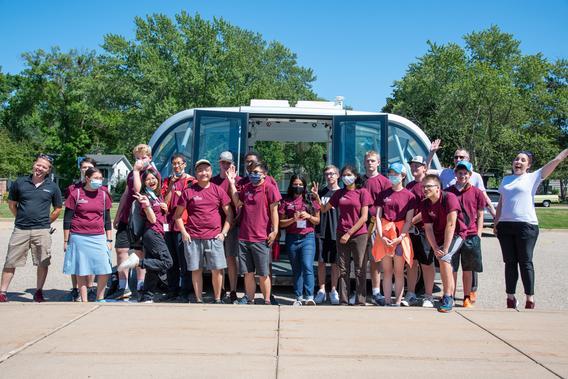October 5, 2021
CAV camp sparks career interests, possibilities for area students
It took traveling less than 50 yards in the brand-new automated shuttle to change Anthony Sabatine’s disappointment to awe. He realized as soon as the bus moved on its own that this was not a kid’s carnival ride in the school parking lot.
“Part of my brain was freaking out not seeing a driver, not seeing someone moving that steering wheel—not even seeing an accelerator pad or anything,” said Sabatine, who, as the son of an auto mechanic, knows a bit about motor vehicles. “Projects like this could make a big difference in our society.”

Sabatine, an 11th grader from White Bear Lake, joined a diverse group of 18 high school students from the Twin Cities participating in the week-long Connected and Automated Vehicles (CAV) Career Pathways Camp. The free camp, sponsored by CTS, was held in August at the White Bear Lake Area High School–South Campus in White Bear Lake, Minnesota.
Campers were among the first to see and ride in the newly arrived Navya AV shuttle bus, part of the White Bear Lake community test pilot project. Project partner AECOM provided an overview of the project, and Navya technicians demonstrated the vehicle in the school parking lot.
William Heise, also a White Bear 11th grader, was similarly impressed with the camp. “I’ve been doing a lot of engineering courses, so it’s cool to see how all of the mechanical, electrical, and computer scientists come together in [CAVs],” he said. “It really showed me a lot of different career paths that I can take.”
“Even if you don’t have interest in engineering or something related to CAV, it’s pretty cool to see how the world is changing around this topic,” observed Roseville 10th grader Naveena Srinivasan. “And it was cool to just learn.”

During the camp, students explored CAV technology and discovered a wide variety of career opportunities in an industry that is helping to shape the future of transportation. Campers received hands-on opportunities with automated vehicles, took field trips to organizations working on CAV technology, and attended information sessions with practitioners and U of M researchers. The students also were among the first to see the U of M’s new MnCAV Ecosystem research vehicle, equipped for level 2 automation, as part of a campus tour.
“They really went into detail about all of the different parts that make an automated vehicle work. And I like how they made us think about it, too,” said Woodbury 11th grader Kaleb Girma.
Minnesota-based Dart Transit visited the camp with a new Peterbilt truck to showcase the latest automation technology used to keep freight moving across the county. Other CAV camp sessions provided up-close demonstrations of sensor technology by SICK Sensor Intelligence, an Indian Motorcycle with Ride Command, and Tesla’s automated parking system.
“It was my first time seeing and sitting in a Tesla. I’ve never felt any more powerful—I felt like Elon Musk,” says North St. Paul 10th grader Ellianna Nguyen. “It’s definitely gotten me more interested in engineering.”
In addition, campers toured Luther White Bear Subaru to see the latest vehicle automation technology available to car buyers, including a demo of a new WRX with EyeSight Driver Assist.

MnDOT’s Office of Connected and Automated Vehicles (CAV-X) introduced campers to a wide range of transportation career opportunities. CAV-X executive director Kristin White guided students through exercises that examined the future risks and benefits of automation, connectivity, electrification, and shared mobility. A variety of MnDOT maintenance vehicles also visited camp to demonstrate the advanced technology used to keep Minnesota highways smooth and safe.
Minnesota leaders have emphasized the need to prepare for broad deployment of CAVs on the state’s roads. In 2019, Governor Tim Walz established a second Governor’s Advisory Council on Connected and Automated Vehicles to continue work in this area. Workforce development is a key part of these efforts.
“We were able to use our research and program experience along with some very strong partnerships to spark the interest of the students,” said Gina Baas, CTS associate director for engagement and education. “The knowledge and skills featured at this camp are critical to the deployment of CAVs. It’s important to attract young people into these new career paths to support future development.”
The camp was hosted by the MnCAV Ecosystem at the University of Minnesota, a collaborative environment that advances CAV-related research, engagement, and workforce development. The camp was funded by the Federal Highway Administration and administered by MnDOT, with additional financial sponsorship from SICK Sensor Intelligence.
CAV Career Pathways Camp program partners
Thank you to the following partners for helping make this camp possible: AECOM, Bolton & Menk, City of Minneapolis Department of Public Works, DART Transit, DeLaval, HDR, Indian Motorcycle, Luther White Bear Subaru, Minnesota State Transportation Center of Excellence, MnDOT Aeronautics, MnDOT Office of Connected and Automated Vehicles (CAV-X), MnDOT Office of Maintenance, Navya, Polaris, SICK Sensor Intelligence, SRF Consulting Group, Stantec, Tesla St. Paul-Maplewood, The Plum Catalyst, and the University of Minnesota.
This article was written by the Center for Transportation Studies at the University of Minnesota and has been reposted by the Minnesota State Transportation Center of Excellence, you can find the original article here.


You must be logged in to post a comment.